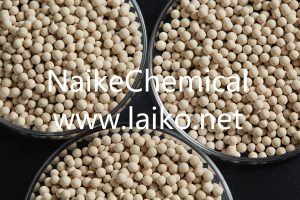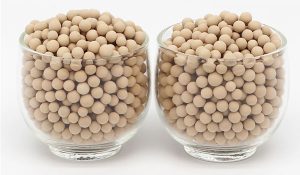What is the Major Use of Carbon Molecular Sieve CMS?
1. What is Carbon Molecular Sieve?
A carbon molecular sieve is an excellent non-polar carbon material. Nitrogen-producing carbon molecular sieve is used to separate air and enrich nitrogen. It adopts a low-pressure nitrogen- generation process at room temperature, which has lower cost and faster nitrogen production than the traditional cryogenic high-pressure nitrogen generation process. Therefore, it is the preferred pressure swing adsorption (P.S.A) air separation nitrogen-rich adsorbent. This nitrogen is used in the chemical industry, oil and gas industry, electronics industry, food industry, coal industry, pharmaceutical industry, cable industry, and metal heat treatment.
Compared with other activated carbons, CMS carbon molecular sieves are a special type of activated carbons with smaller pore sizes. Activated carbons have a wide range of pore sizes, with a typical average pore size of 20 Å, while carbon molecular sieves have a narrower pore size ranging from 3 – 5 Å.

2. Carbon Molecular Sieve Properties
The pores of CMS facilitate the diffusion of small molecules and inhibit the penetration of macromolecules, therefore it provides clear separation compared to common activated carbon. Another important property of CMS is the slit-like pore structure, which makes them useful for kinetic separation and adsorption equilibrium.
Gas separation is achieved by two alternative mechanisms: kinetic separation and selective adsorption. Kinetic separation is based on kinetically controlled gas diffusion caused by the shrinkage of the pores. The diameter of the bottleneck pores is in the same range as the diameter of the adsorbed molecules. Therefore, when CMS is used in an air separation process, oxygen molecules, which are smaller in diameter than nitrogen molecules, can penetrate the pores faster than nitrogen molecules. Therefore, nitrogen is highly recovered, while almost all oxygen is adsorbed. In the second separation mechanism, the pore system is wide enough for fast diffusion; the separation is caused by selective adsorption, which depends on the van der Waals forces between the carbonaceous substrate and the gaseous species.
3. What is the Major Use of Carbon Molecular Sieve CMS?
The main use of Naike Chemical CMS carbon molecular sieve is to separate pressure swing adsorption air(PSA for short) to produce nitrogen. Because nitrogen is a colourless, non-toxic, odourless inert gas with very stable chemical properties, CMS carbon molecular sieve nitrogen equipment has a very wide range of applications in the industry :
Metal processing: nitrogen supply in heat treatment processes such as bright quenching, bright annealing, nitriding, nitrocarburizing, soft carbonization, etc., and the use of nitrogen as a protective gas in welding and powder metallurgy sintering processes, etc.
Chemical synthesis: provide important nitrogen raw materials for industrial synthetic ammonia, synthetic fibers (nylon, acrylic), synthetic resin, synthetic rubber, etc.
Electronics industry: as a nitrogen source in the processing of large-scale integrated circuits, color TV picture tubes, TV and radio components, and semiconductor components
Metallurgical industry: nitrogen can be used as a protective gas for continuous casting, continuous rolling, and steel annealing in the metallurgical industry, and can also be used as converter roof and bottom composite nitrogen blowing steelmaking, converter steelmaking sealing, blast furnace roof sealing, blast furnace ironmaking pulverized coal injection gas, etc.
Food preservation: nitrogen-filled storage and fresh-keeping of grains, fruits, vegetables, etc.; nitrogen-filled fresh-keeping packaging of meat, cheese, mustard, tea, and coffee, etc.; nitrogen-filled and oxygen-exhausted fresh-keeping of fruit juice, raw oil, jam, etc.; various bottles purification and coverage of wine, etc.
Pharmaceutical industry: nitrogen-filled injection of medicine, nitrogen-filled storage, and container, air source for pneumatic transportation of medicinal materials, etc.
Chemical industry: replacement, cleaning, sealing, leak detection, protective gas in dry quenching, catalyst regeneration, petroleum fractionation, chemical fiber production, etc.
Fertilizer industry: nitrogen is the raw material for nitrogen fertilizer production, and can also be used as a replacement, sealing, washing, and protective catalyst in the process of fertilizer production.
Plastics industry: pneumatic transmission of plastic particles; anti-oxidation in plastic production and storage, etc.
Rubber industry: rubber packaging, storage, tire production, etc.
Glass industry: nitrogen is an ideal protective gas in the production process of float glass
Petroleum industry: nitrogen-filled purification of storage, containers, catalytic cracking towers, pipelines, etc.; pneumatic leak testing of pipeline systems, etc.
Warehousing: inerting with nitrogen to prevent flammable materials in cellars and warehouses from catching fire and exploding.
Mining: The use of nitrogen fire-fighting technology in coal mine production is one of the effective technical measures to prevent and control fires in coal seams.
Paints: Paints and coatings are filled with nitrogen and oxygen to prevent the polymerization of oil drying.




